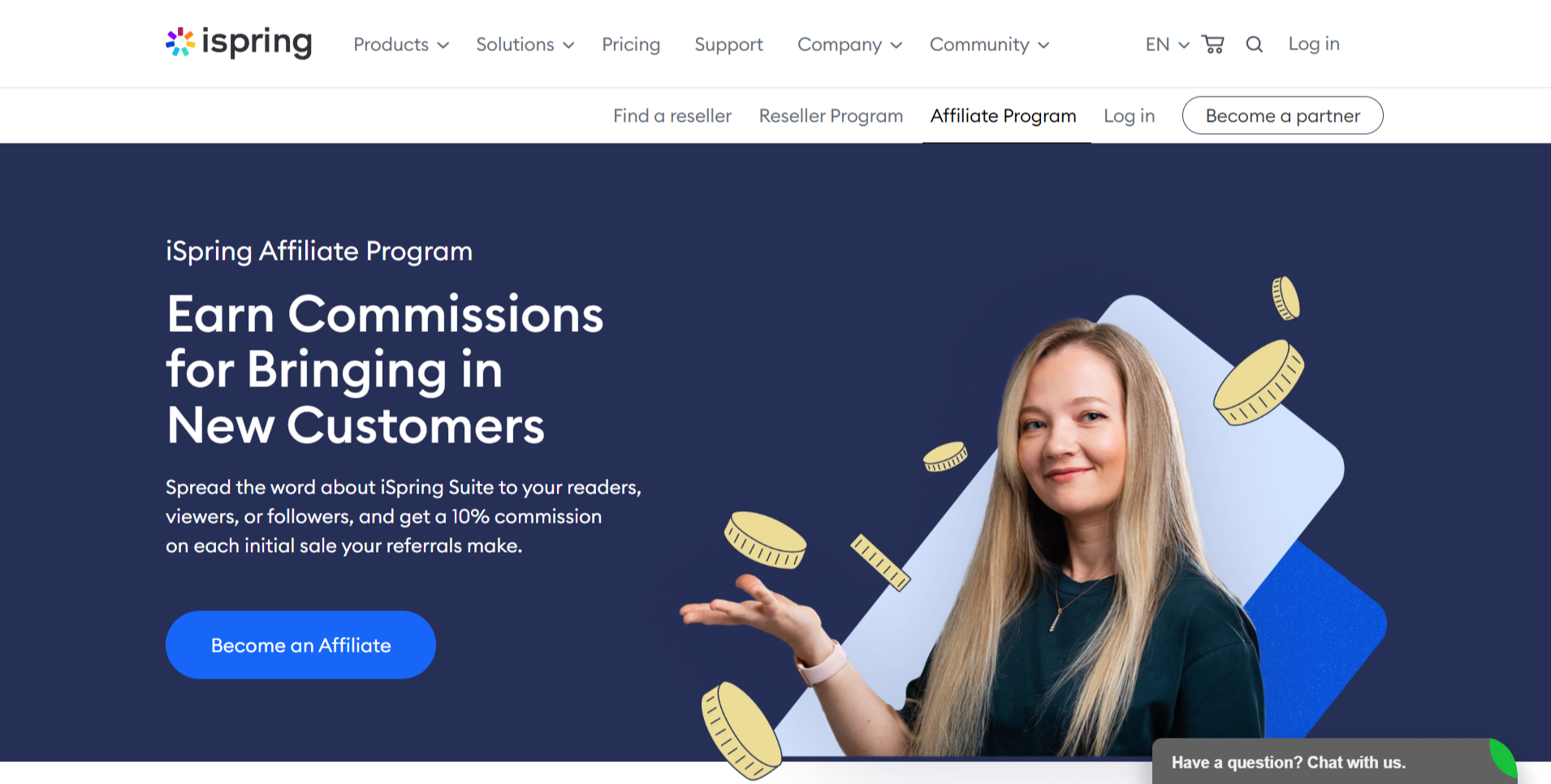An affiliate program is a program that implies a company paying money to an opinion leader or another company to increase its website traffic and sales through social media posts, product integration, or some other types of content. An affiliate receives a commission from each purchase recorded through a unique affiliate link.
In this article, we’ll uncover how affiliates make money and review types of affiliate programs. We’ll also provide a guide on creating an effective affiliate program and some great examples.
How do affiliates make money?
If you are considering an affiliate program for your business for the first time, you need to explore its peculiarities first. In this section, we’ll uncover how affiliates make money by promoting businesses and making sales.
The revenue of every affiliate depends on the clicks and purchases of customers. A company provides an affiliate (another business or influencer) with a unique link called an affiliate link. With the help of this link and cookies, a business can monitor how many people have clicked the link and how many of them have completed the checkout process. After clicking an affiliate link, users should buy items during a specific timeframe given to an affiliate. An affiliate company receives a commission for every completed purchase. A brand and affiliate decide on the sum of money provided for every sale. It can be a predefined sum or a percentage from a sale.
Businesses use cookies to track the activity of users. Each cookie has a specific length for monitoring the customer’s activity and actions. That’s why an affiliate should encourage a referral to purchase within this time. For instance, a cookie can monitor a user’s activity for 15 days. That’s why an affiliate should strive to complete sales until an affiliate link expires. Once this period ends, cookies can’t track customers’ actions any longer, so an affiliate can’t get paid. To receive proper commissions, affiliates should always operate within a given timeframe.
Now that you know how affiliates make money, it’s time to explore the existing types of affiliate programs.
Types of Affiliate Programs
You can consider different types of affiliate programs depending on your key goals, target audience, and preferred communication channels. Before choosing a program, you need to identify platforms where your consumers prefer to spend their spare time. After conducting short research, you’ll be able to find out which type of content your audience reads most often. Afterward, you can identify the most relevant program. So, in this section, we’ll review four main types of programs that will be helpful for your product promotion.
- Cooperation with influencers. Nowadays you can find promoters in every industry. So, if you know some influencers with the same target audience, you can ask for a partnership. Since 61% of customers trust recommendations from opinion leaders, we can conclude that bloggers and social media influencers have a huge impact on people’s shopping decisions. For example, if you sell beauty products, an influencer can include your items in the next tutorial in Instagram stories as a recommended product for different skin types. As a result, viewers become interested in the product and click the link to explore available products, pricing, and their value. If prospects purchase, influencers receive revenue.
- Email marketing. Sending email campaigns to people who don’t need your product is useless. Yet bulk emails are effective when sent to the right people. To reach such an audience, consider various partnerships with appropriate businesses. For example, if you have a social media listening tool, you can cooperate with marketing agencies. When they send email campaigns to their customers, they can include a link to your product. If these users find your product helpful, they will use it to their advantage. As a result, your audience will expand.
- Coupon websites. Consider partnering with coupon websites when your product isn’t selling quickly within your market. This partnership lasts for a specific time and helps you promote your product. This way, you can get the first customers who will visit your website and become word-of-mouth promoters of your product.
- Search affiliates. This type of affiliate program implies partnering with freelancers who promote your brand in search results or other influential online advertising platforms. You should control whether this person or business complies with your advertising guidelines during this time. This partnership is more beneficial if your partner has a background in SEO and can launch an A/B test to identify ads that bring many referrals for your business. This step is essential for your partner since it helps determine ads with the highest ROI.
- Review websites. Costly products often require a special approach from brands and customers. When consumers want to buy an expensive product, they need to explore information, features, benefits, and reviews. Usually, such research needs more time. Consumers look for review sites to see if comments are positive. To bring more sales to your business, you need to contact review sites that have reviews of your product. Ask these businesses to cooperate with you by adding a referral link to the text about your product. As a result, both of you benefit.
Now that you know the types, it’s time to proceed to the guide on developing an effective program. We’ll provide you with the steps you should take to obtain great results.
How to create an effective affiliate program?
After determining a relevant program for your company, it’s time to jump into its implementation. We’ll provide a step-by-step guide on how to do it right.
- Determine your goals. Before identifying your goals, make sure that you have a buyer persona. It will set the direction for your goals. Think of the people you want to reach and define the best approach to do it. Once you finish with the audience, proceed to measurable goals. Identify and set your KPIs to determine whether your program is effective and assess its benefits. You need to determine the sum of money you want your affiliates to bring each month, quarter, and year. Besides, set objectives for conversion rates. To track the effectiveness of the program, you should know how many people you want to convert into customers. Consider determining your expectations regarding clicks, average order value, leads, numbers of unique affiliate sales, and impressions.
- Look through rivals’ programs. Although you might know the strength and weaknesses of your competitors, you still need to do research focusing on affiliate programs. Search for at least a few rivals with the same audience and affiliate programs.
- Analyze what programs and how they implement them. This will help you set the direction of your future program and reach your target audience. Identify the structure of their affiliate commission (actions that trigger the payout, types of payments to affiliates, the amount of commissions, etc.). Afterward, see how competitors search for affiliates and what terms and conditions they provide. Once you figure everything out, your final step is a SWOT analysis. You’ll need to identify each affiliate program's strengths, weaknesses, opportunities, and threats.
- Define affiliate commission. The next step implies defining the sum of money you are willing to pay your affiliates, called commission. See competitors’ commissions to decide which commission will be enough for promoters. Make sure that the business or individual that will promote your product receives money for sales. There’s no need to pay for clicks or impressions since it won’t generate revenue. Make sure to negotiate these points. When determining a commission, you need to take care of your company’s interests first. Calculate customer acquisition costs, retention rate, and average customer lifetime value to find appropriate payment. You have two options to pay: set a specific sum of money for each sale or offer a percentage of a sale. Besides, you need to decide whether you are ready to pay in cash or store credit.
- Outline program structure. Once you are done with a commission, it’s time to determine your program structure. First, find the best ways for affiliates to distribute links to your product. You need to conduct research to identify the channels your prospects prefer the most. These will be the platforms for affiliates to share links. Secondly, identify the timeframe for the activity of your cookies. Thirdly, consider the terms and conditions that will apply to this program. You should also figure out the competitive advantage of your affiliate program that will help it stand out from the competition. Finally, decide whether you need an affiliate manager for this program and search for this person.
- Search for affiliates. To search for affiliates, you need to use an existing network of affiliates or create your own. With an existing network, you’ll be able to find an affiliate quickly but for a specific commission. This way, you’ll need to pay twice: finder’s free (up to 30%) and commission for the affiliate. Say you pay $10,000 per month to your affiliate, so you’ll need to pay an extra $3,000 to your affiliate network for their services. If this way is too costly for you, consider forming your own network of affiliates. You’ll need affiliate marketing software to monitor the performance of your affiliates. However, it’ll still cost less than an existing network. To find affiliates, write a list of bloggers, opinion leaders, and social media influencers that share the same audience and have a strong impact on people. Choose industry leaders with a good reputation and the trust of the masses. Contact these people and ask for partnership. Consider placing an open affiliate application so that potential affiliates contact you for more information.
- Monitor your program progress. Use affiliate program software to instantly track your results and program effectiveness. It’ll provide you with insights into your sales. You’ll be updated on the most successful affiliates. You’ll see whether you meet your measurable goals as well.
Now that you know how to incorporate an affiliate program, let’s see some excellent examples from famous brands. It’ll serve you as an inspiration for your future program.
Best Affiliate Programs
In this section, we’ll uncover some amazing examples of affiliate programs from famous brands. They will help you find the best solution for your business.
Fiverr
Fiverr is a huge online marketplace for freelancers. The service helps businesses find the right candidates and freelancers get their desired jobs.
The platform has an affiliate program on its website, so anyone can join it. Individuals and businesses start for free while having access to all tools Fiverr provides. Afterward, these people should share words with their followers about Fiverr and promote it. Once traffic converts, affiliates receive commissions. Since the company has different products to offer, the payouts depend on that product. Depending on the category a customer buys from, affiliates receive various commissions, ranging from $15 to $150.

Elementor
Elementor is a software company that helps build websites. Its drag-and-drop editor enables users to design sites with ease.
The company offers a powerful affiliate program to individuals with the same niche and audience. The program is available for everyone with a strong online presence ready to generate conversions for Elementor. The platform invites content creators, web educators, marketing agencies, and digital entrepreneurs to join the program and become brand advocates.
Elementor offers great payouts. Affiliates get a 50% commission from every purchase. The company pays automatically through PayPal or other preferred payment methods.

iSpring
iSpring is a platform that empowers users to build interactive learning materials like courses, quizzes, dialog simulations, screencasts, and video lectures. The company invites affiliates to participate in its program and bring new customers. The service encourages brand advocates and industry leaders to spread information about iSpring Suite to readers and receive a 10% commission for each purchase referral completed.
The affiliate program is simple, and individuals and businesses can apply for free. The company looks for people who have experience in eLearning, understand iSpring software, and possess a network of iSpring prospects. Affiliates fill in a short application form on the platform’s website and wait for a response. The chosen candidates should use the unique link provided by the company to recommend iSpring on affiliates’ websites or social media. Once there’s a sale, an affiliate gets paid.

Congrats, now you know what affiliate marketing is and why it’s essential. Hope that our examples inspire you to launch your own program soon.
References:
- This article shares 19 affiliate marketing trends to look out for in 2023.
- This article defines the term and unveils how to get started with affiliate programs.
- In this article, you’ll find 5 great examples of affiliate programs.
Last Updated: 21.03.2023

or